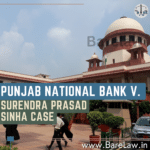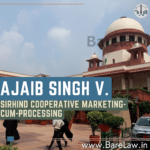
Jurisdiction: Criminal Appellate Jurisdiction: Bombay High Court
Case Filed (in years): 1876
Case Decided (in years): 1877
Judges: Justice Melvill, Justice Kemball, N Haridas
Case Brief Prepared by: M Balaji
Case Brief: Reg v. Govinda (1877) ILR Bom 342
Introduction:
One of the most important concepts or theories under criminal law is the principle of concurrence.
It requires that any offence committed should satisfy the Principle of concurrence.
In other words, the principle of concurrence means that a mere act would not amount to offence in a general scenario unless there is an exception mentioned to the same.
Thus, one such example can be seen through this case brief, where the court stresses the importance of section 300 and interprets the meaning of the same.
This case is an exception that is, culpable homicide not amounting to murder.
Facts of the case:
The facts of the case are that the accused in this case was an 18-year-old prisoner,
who had been charged to have kicked/thrust his wife – who was reported to be 15 years of age.
It hereby was also noted that the accused might have struck his wife several times with his fist on the back.
As per the report, these blows inflicted on her caused less serious injuries.
But then, she later fell to the ground and as per the evidence reported by both the investigator and the sessions judge, the accused/prisoner then put his knee on her chest area and struck her more than twice on her face.
These two or more later blows on her chest and face were noted to be violent by the medical evidence.
This, which was delivered with the closed fist, had made an impact on the girl’s left eye and later it resulted in discolouration and bruise.
These impacts that followed by the offender’s blow resulted in the girl’s death either on the spot of the incident or shortly right after the incident took place.
With these facts and shreds of evidence in hand, the sessions judge and the assessors of this case found the accused prisoner guilty of the offence of murder under section 300 and was later sentenced to death.
Issues:
- Whether the accused-the prisoner had the required intent to commit the offence of murder specified under section 300 of the Indian Penal Code?
- If so, can be held guilty of murder?
Laws involved:
- Section 300 of the Indian Penal Code
Section 300 of IPC deals with a culpable homicide that will amount to murder if the act to cause death was done to cause death or the act is done to cause bodily injury and the offender has the knowledge that such injury will cause death or thirdly, the offender had the intention to cause death and mere bodily injury would suffice as the cause of death during the ordinary course of nature.
The section is as follows,
“Except in the cases hereinafter excepted, the culpable homicide will be murder, if the act by which the death is caused is done to cause death, or
Secondly.—If it is done to cause such bodily injury as the offender knows to be likely to cause the death of the person to whom the harm is caused, or—
Thirdly.—If it is done with the intention of causing bodily injury to any person and the bodily injury intended to be inflicted is sufficient in the ordinary course of nature to cause death, or—
Fourthly —If the person committing the act knows that it is so imminently dangerous that it must, in all probability, cause death or such bodily injury as is likely to cause death, and commits such act without any excuse for incurring the risk of causing death or such injury as aforesaid”
Section 299 of the Indian Penal Code:
Section 299 of the Indian Penal code defines Culpable Homicide. It states that
- whoever causes the death by doing any act with the intention of causing death or
- with the intention of causing such bodily injury as is likely to cause death, or
- with the knowledge that he is likely by such act to cause death, commits the offence of culpable homicide.
Analysis of Decision:
The court analyzed the difference between culpable homicide not amounting to murder and murder under section 300.
It referred to clause (a) and subsection (1) and stated that, in order to prove the offence of murder,
the intention to kill should be present as per the two clauses mentioned above.
That is to say that if A is charged with murder, both clauses should be proved to ensure his guilt.
In the same way, clause (c) and (4) was interpreted to mean that there will be no intention to cause death or bodily injury.
A few examples of such clauses include the Furious driving, etc.
Also
In such cases, whether the offence committed is culpable homicide or murder is fully dependent on the degree of risk to human lives.
It is noted that if death is a likely result then it would be a culpable homicide, and if death is the most probable result then such would be decided as murder.
Court also analyzed that the essence of subsection 2 of section 300 is that if the person who commits the offence knows that there will be a death due to an injury that can easily cause the death of the victim, then such an act and result in death would directly fall under the definition of murder.
Finally, the court opined that they found neither the evidence that is, the presence of evidence to cause the death of the victim nor the bodily injury which would suffice the death in the ordinary course of nature.
In the ordinary course, there would not be a death, but in this case, the court stated that two or more later blows on her chest and face were noted to be violent by the medical evidence and the resultant concussion or extravasations of blood from the brain which appeared on the surface showed that how death could occur due to mere blow on the head area.
Conclusion:
In this case, the court held that the accused, who was sentenced by the sessions court should be punished for his guilt for culpable homicide not amounting to murder as they did not find the intention part for the conviction under section 300. Thus he was ordered and sentenced to seven years of imprisonment.
You may also like to read:
29 Jul 2021
Case Briefs
Case Brief on Virsa Singh v. The State of Punjab (1958) AIR 465
18 Aug 2021
Case Briefs
I.R. Coelho v State of Tamil Nadu
25 Aug 2021
Case Briefs
Case brief of K. M. Nanavati v. the State of Maharashtra
03 Jul 2021
Case Briefs
Sakshi vs Union of India
10 Jul 2021
Know Your Law
Culpable Homicide and Murder
also read – https://indiankanoon.org/doc/783074/










